The Honda Grand Prix of St. Petersburg Indy Car race got rained out on Sunday (the shot above is from the 10 minutes I got to shoot the Indy Lights race in the rain on Sunday). There was just too much water on the track, and so after spending all of Sunday waiting in the Media Center for the rain to break, they rescheduled the main Indy race to run at 10:00 am on Monday (yesterday). NOTE: Click on the images for a larger view.
I was there shooting the race on assignment for Southcreek Global Media, so even though the race got rescheduled, I really needed to be there, though a lot of photographers (and unfortunately fans) weren’t able to be there on Monday. The upside was—there was a lot of room to shoot, so there was no jockeying for position—you could pretty much shoot where you wanted to. The downside was—the stands weren’t packed, so I just pretty much avoided having them visible in the background.
Here are some of the shots from the day (the thumbs up in the shot above is because he just took second place).
TECH SPECS: I shot with just one camera all day; a Nikon D3, with a 70-200mm f/2.8 lens, with a 1.4 tele-extender to get me a little closer to the action. I had my 200-400mm in the car, but since I had to cover so much track, I decided to go with a lightweight set-up instead. I took my Boda Lens bag, and in it I had two other lenses; my 14-24mm f/2.8 and a Fisheye, and I switched lenses at almost every turn (they cut some rectangular holes in the chain link fence so the photographers have a clear unobstructed view to the track, so once I shot with the long lens, I switched and shot with the other two for a lap or two each).
I used two different sets of settings. I was really trying to make sure that most of the shots had some movement in the tires and wheels (as seen above), so the cars look like they’re moving and don’t look like they’re just parked on the track, so most of the time I shot in Shutter Priority mode at 1/125 of a second or 1/60 of a second, and I panned with the cars as they went by.
When you do this technique, you wind up with a lot of blurry photos as you’re panning (because of the slow shutter speed), but then all of sudden you have one that’s really sharp, but with a blurry background and wheels spinning and that’s the goal (so you have to kiss a lot of frogs before you find a prince).
If the cars were coming directly at me (like the one you see here), I switched to Aperture Priority mode, and shot wide open at f/4 (you lose a stop because of the 1/4 tele-extender, so your f/2.8 becomes an f/4 lens). If the car turns a little, you see the wheels are frozen (because now you’re shooting at a shutter speed of more than 1/2,500 of a second in daylight which freezes the motion), but if you look at a lot of pro IndyCar shots, you’ll see a lot of frozen wheels, so I didn’t lose much sleep over it. For post production, mostly just selectively adding contrast and sharpening, but two images got slight vignettes added.
The race was just over 2 hours, and I covered the course from one end to the other, and then I went directly to the trophy presentation, and then uploaded 21 images to Southcreek Global, after adding the appropriate metadata and naming conventions.
The weather turned out to be great, with blue skies above, and the temperature was a perfect 68 degrees with a slight breeze. It was a prefect day for a re-race. :)



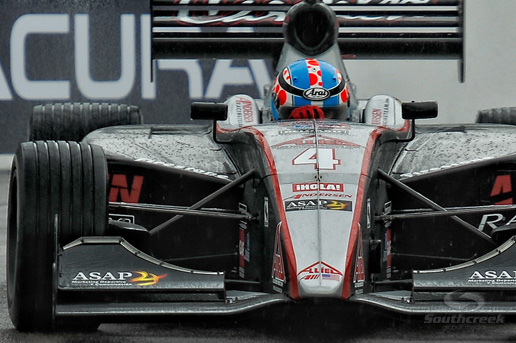
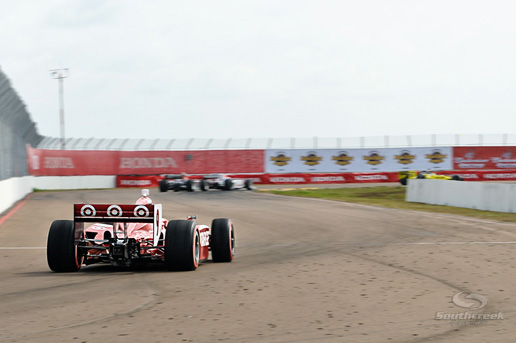
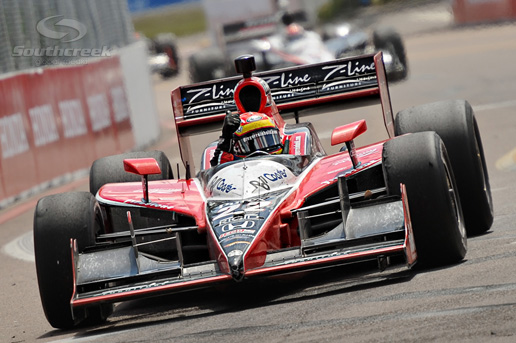
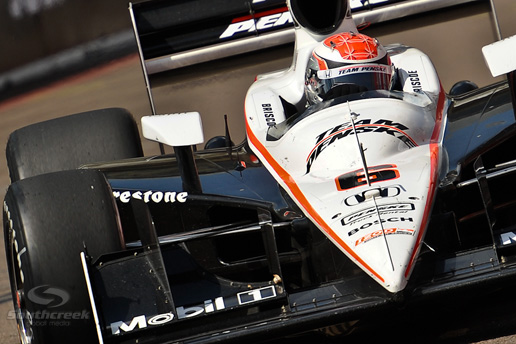
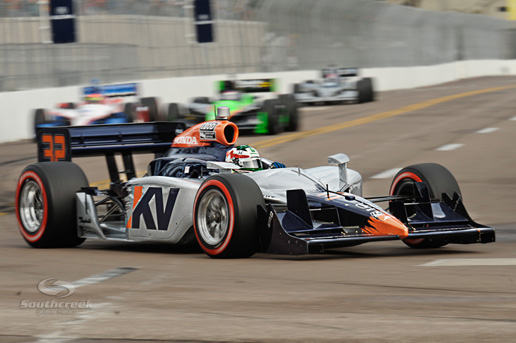
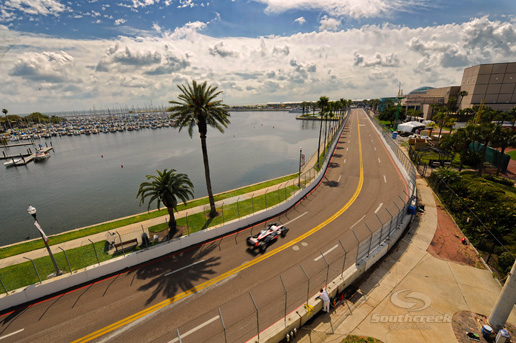
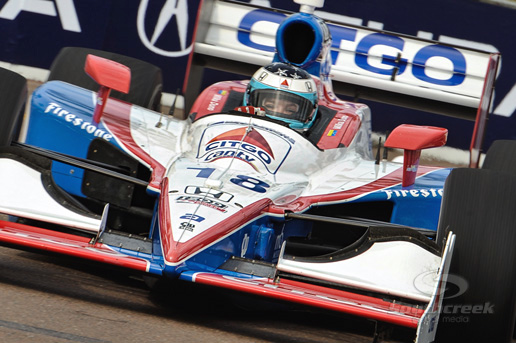
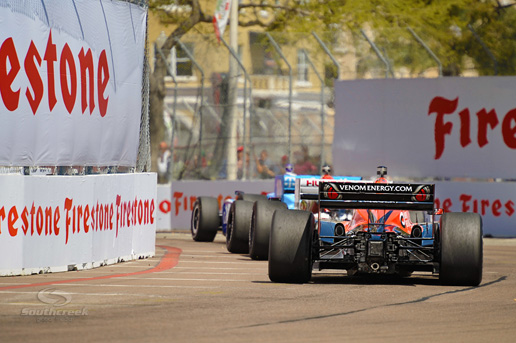
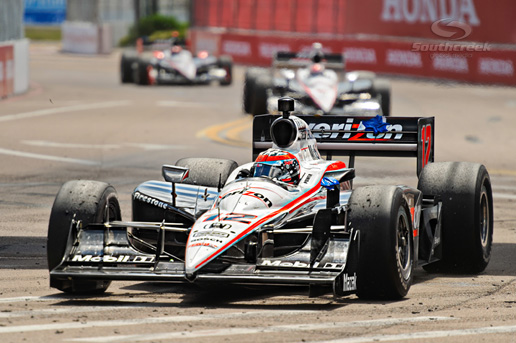
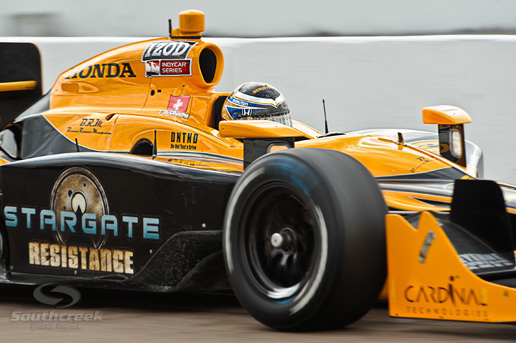
Scott, are you using both or either the new 70-200 VR11 and/or the new teleconverter? I am considering replacing my 1st generation VR 70-200 but I think the new 1.4 telecon may be a better choice. I sure would like to loose that vingetting ( even if it’s easy to remove in PS). Are you using either one here?
The first shot is real good.
I am sure it’s great fun to shoot these fast pacers and get a still shot using such fast lenses and shutter speed.
Nice photos, Scott (c’,
Thanks for the shotinfo – I’ll go try this next weekend. And thanks for a great blog!
Hi Scott,
this maybe a little bit off topic but I like to know if there will be a worldwidephotowalk in 2010. I loved it last year!
You took some really nice pictures in St. Petersburg. Good job!
By the way your blog is awesome!
Were the 21 images you uploaded your main keepers or just what you uploaded at that time? Out of how many? Sorry, just curious. :)
Hi Neil:
These aren’t the ones I sent to Southcreek—these were some of my favorites. I had around 1,300 shots to choose from (I was shooting in Burst mode a lot of the time).
Hope that helps.
-Scott
Scott are you allowed to post the ones you sent to S. Creek or use them for any personal use? Maybe a blog post on how it is to work on an assignment, the can do’s and dont’s it would be interesting.
As long as there is a watermark they can be posted.
Hey Scott,
Great pictures – reminds me of phtographing Formula 3 in the U.K. when Ayrton Senna was a rookie (rain delays, empty stands, freedom to move,…). Of course, back then I was burning through film so I mostly shot B&W.
For your motor sport shots, do you shoot JPEG as you recommend for football and other sports or do you shoot RAW (or both)?
Hi Richard:
I shot in JPEG fine mode the whole time.
-Scott
Thanks Scott!
I love these posts where you give all details and specs about a special shoot. These are great tips for up coming photographers like me who never had the chance to shoot in the big leagues yet. I just know how to prepare myself and my gear if I ever get asked to do a similar assignment.
Keep them coming!
Great stuff, Scott–always love to see your IRL coverage.
Go Team Penske!!!
Scott,
Thanks for sharing these–very engaging post, today.
I wanted to share a little “Scott Kelby Experience” I had the other day.
While you were enjoying PSW, I was working in Vancouver, BC (I’m from Utah). I had time to do some shooting around town, so I went to Stanley Park and got set up to do some cityscapes. So there I am bent over my tripod making adjustments when I feel someone leaning over me. I looked back and an Asain looking man is inspecting my setup. I tried speaking with him, but he made it clear that he didn’t speak English. After several minutes of sign langauage and inspecting one another’s Nikons, I got it out of him that he was from China–which is perfect because I speak Mandarin pretty well. So, for the five hours Mr. Kuang showed me around some great places to shoot, and I helped him with some settings and we had a grand ol’ time.
The thing is, he kept telling me these tips he read about from a “famous professional American photographer”, and they were tips that I was pretty sure I had read, as well, but he couldn’t recall the guy’s transliterated name. Finally, as I’m shooting straight down on a flower, he quotes this guy again, “You know, you try to get a different perspective on thosew since that is the view everyone always sees,” he said. And that clinched it! now I knew he was quoting your digital photography books. we had another good time reciting our favorite tips.
It was great for me, too, because I not only had a great time shooting pictures with a terrific fellow, but I also learned loads fo new vocabulary in Mandarin.
See Scott? your books bridge culture and language barriers and unit ephotographers around the world!
And my complements to your translators.
Levi
Typo for “trophy”….but otherwise great photos and I’m a big fan of your site.
Hi Manmeet:
Thanks for catching that—I just fixed it. :)
-Scott
Scott,
Great pics and thanks for posting the tech specs on the shoot. This will be very helpful this summer as I am shooting NASCAR @ Michigan International Speedway.
Scott,
Great images! You’re a natural at motorsports. I can’t tell you how long it’s taken me to get where you’re at in shooting those fast moving objects. When you combine the sights, sounds, and smells while shooting motorsports, it’s hard to find a more exciting place to be!
Thanks for sharing your knowledge and images!
Don
Hi Scott,
Fantastic shots. I’m a motorsport nut, and have been since I was a young child. Anytime I can watch a race, I will. Anytime I can take photo’s of races, I go. And to top it off, every time I can view racing photographs (new or old), I’ll put everything down and look at them. So it was with great pleasure that I opened your blog today and saw these shots. Thanks for these!!
I’ve never had the pleasure of having media credentials for a race, so I’ve made due with spectator areas. I’ve also, somehow, almost impossibly, got myself in to a Formula One garage area in 2008. have to say, it was something else.
Here’s a collection of the work I’ve done since 2007. You can see the progression, and confidence I got in my shooting techniques.
http://www.flickr.com/photos/aperture_priority_photography/sets/72157623735641836/
Have a great day!
Jason
Hi Scott,
Great story and pictures. I photographed the Australian F1 on Friday from outside the fence and also used a slower shutter speed to get the blurred tyres with mixed results. I deleted maybe half of the photos, but did end up with about 50 great shots. (Can shots be emailed to you for criteque)
Thanks for sharing your tech specifications as they enable amatuer photographers to gain an insight on how the pros work.
Thanks for your fantastic site.
Now that you are shooting more sports, maybe your next book could have a section devoted to sports photography.
Andrew
Scott,
kind of a continuation of Aaron Noble’s post. I cover college football for ICON SMI in Oregon and I was thinking it would be cool if you did a video of your post production process when you are on deadline and how it works from the time you pull out the memory card to the time you send off your final pics.
Thanks.
AJ
Hi AJ:
Believe it or not, this is the part of the process I’m most unhappy with. The processing isn’t taking any time, but finding the picks and then adding the metadata is taking me WAY too long.
I did use a Firewire 800 card reader, and a 675x speed card, and that helped a lot in getting the images on my drive really fast, but after that, my workflow falls apart, because it’s taking too long to get to the ones that I’m going to upload.
I’m going to call a friend who does this for a living, and ask him what he does, ’cause I’m obviously not doing it right. Once he tells me what I should be doing, I’ll pass it on. :)
Thanks,
-Scott
Scott,
This season I made a jump from using lightroom for the whole process, to importing and adding metadata with Photo Mechanics which sped things up quite a bit. Mainly because of the ability to use text replacement so instead of having to type out the entire players name I could simply go D350 which would fill in the name of number 35 on the ducks who played offense.
Until i can find a way to do that in lightroom (maybe there is, i just dont know of it) i have to start in PM then move to LR to make my crops and color corrections.
Let me know what you find out from your friend.
Thanks,
-AJ
Really neat Shots…Thanksabunch
Scott,
Wonderful photos. I’m really going to try to get back into photography after being away for 30 years! My favorite photo subject is MotorSports and I really enjoyed looking at your shots.
Now, for my question, nowadays do you need press credentials to get into the areas where you shot? I was just trying to figure out my DSLR and went to Mid-Ohio last year and they’ve basically ruined the course for pro-am photogs (opinion voiced by many photogs that I spoke with). Did you need to get credentials from the sanctioning body, too? or from the track/promoters?
Many careers ago, I drove in IMSA and SCCA and new everyone at the races, so I didn’t need credentials to get up close to the track, but I think those days are gone :(
Cioa, Danté
Scott,
You used the 70-200mm with a 1.4 tele-extender. I have the 1.7 tele-extender and the same lens. I plan on shooting at the Richmond Nascar race in May. Will mine work okay, or should I invest in the 1.4? Is there a big difference when shooting motorsports?
Hi Skip:
The downside to the 1.7 tele is that you lose two stops of light. That probably wouldn’t be a big problem shooting in daylight. Of course, the upside is that you’re that much closer to the action, which is huge! If you shoot in daylight, I’d go for it.
-Scott
@AJ
Hi AJ,
i am no big expert in Lightroom, but shouldn’t the alias function work like that?
You define the Full name of the players and assign an alias to them before the game
starts. After the game you only use the short aliases then…
(This is just out of my brain, i am still at work without LR :-(
Kind regards,
Marc
Great entry! I have never shot motorsports before but hope to have a pass for Barber’s Indy Grand Prix next week. I appreciate the tech info that you gave. Thanks.
Definitely a lot of frogs before you get a prince or two when it comes (and goes) to fast . I shot the Rolex 24 at Daytona this year with a 70-210 f4. Just wanted something light. Even though it was raining at the start of the race , you still had to battle for position with all the people trying to get shots. I shot it it with a 300 2.8 and a 500mm a few years ago. I used to like the Daytona 200 motorcycle race but then they went to a night start. Eke.
Here’s a few of mine from the Rolex: http://www.flickr.com/photos/markpino/4338645146/in/set-72157623250685663/
Great photographs Scott. I would love to see some ‘Formula One’ photographs from you… maybe when it comes back to Indianapolis…
Scott –
Are you shooting at Indianapolis this week? I’ve been running up and down the pit lane, garages and outside stands for 5 of the 6 days so far and it’s been great. I just may need to see a chiropractor after all is said and done…
Greg